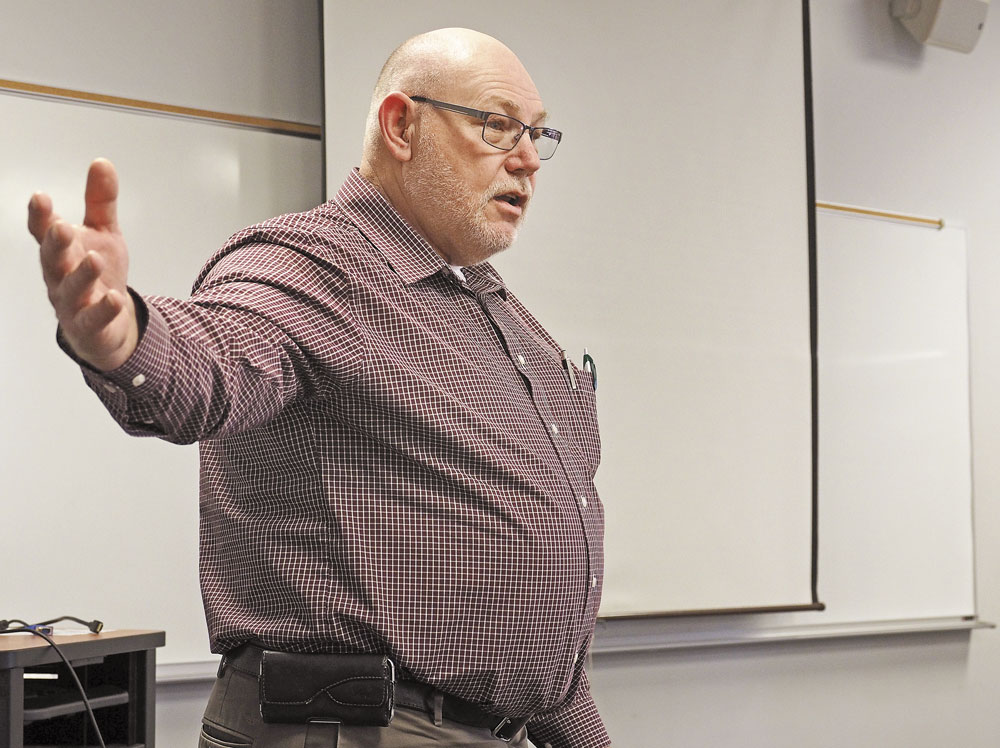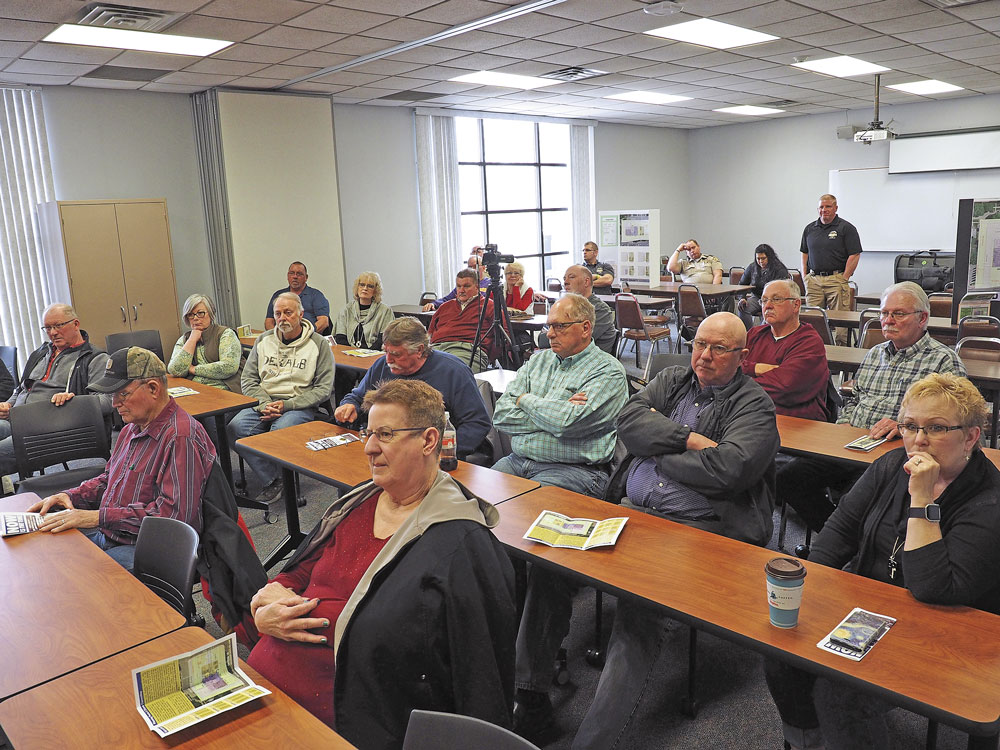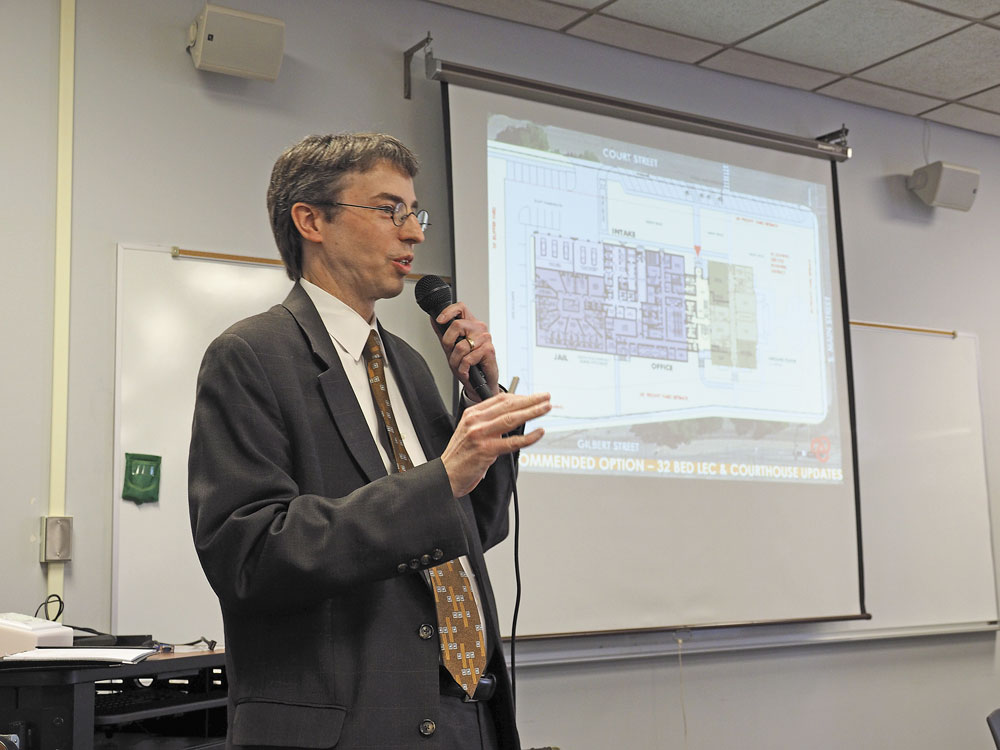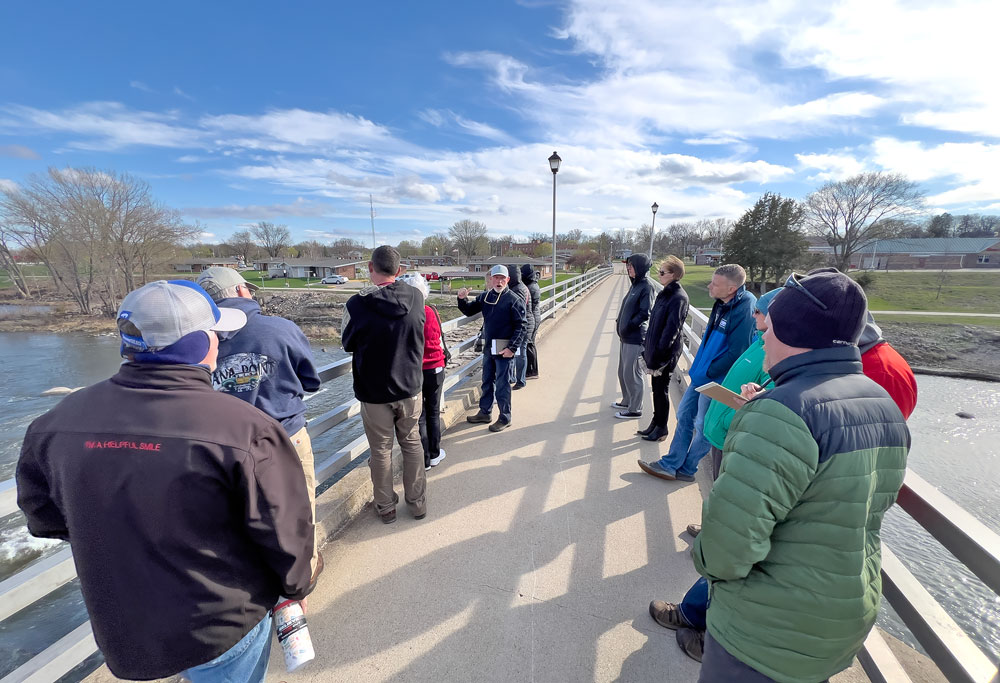Jail inspector: Floyd facility almost as bad as one state closed
By Bob Steenson, bsteenson@charlescitypress.com
Earlier this year the state ordered the Warren County Jail to close, and the Iowa jail inspector said Saturday that the living conditions in that facility were “not a whole lot worse than what you have here” in the Floyd County Jail.
Iowa jail inspector Delbert Longley was one of several speakers at an informational meeting held Saturday morning in Charles City. It was Longley’s reports beginning several years ago on the condition of the Floyd County Jail that prompted the effort to build a new jail.
A vote on selling up to $13.5 million in bonds to finance construction of a county law enforcement center including a jail, along with renovations to the county courthouse, will be held Tuesday, May 1, for all Floyd County voters.
Longley said state jail standards were developed in the late 1970s in response to a lawsuit filed by inmates in Scott County over living conditions, that resulted in a $5 million out-of-court settlement — a figure he said would be about $25 million in today’s dollars.
“My job, I believe, No. 1, is to keep you out of a lawsuit,” Longley told about three dozen people attending the Saturday morning meeting.
“When I come into your facility and I see something that’s not right, I need to tell you,” he said. “I’ve said you’ve got a problem here. You have a facility that’s not safe for staff. You have a facility that’s not safe for inmates. You’ve got a facility that doesn’t meet the public’s needs.”
Longley said the state standards don’t require giving detainees plush amenities.
“What I am saying is you need to be able to provide their basic needs,” he said. “You need to provide a facility that your staff can work with safely, effectively and efficiently. Those things are not in your current facility.”
He said one of the big problems in the current jail is lack of separate spaces to classify detainees. For example, males have to be separated from females. Juveniles have to be separated from adults. People who are awaiting trial should be separated from people who have been convicted. People who are likely victims should be separated from people who would exploit them.
“When I quickly look at the proposed plan that’s here, I would say that you have a very good concept. It’s very user-friendly. It is a concept that’s going to meet classification needs,” Longley said.
He said the fact that the current jail is built with bars instead of solid doors and windows is a big safety hazard. “That’s a suicide tool waiting to happen,” he said.
“The type of system you have there, staff can be assaulted so easily,” he said. Detainees “can reach through the bars, they can punch somebody, they can throw urine, they can throw feces and anything else on them.”
“You have no control over those inmates, you really don’t,” he said.
“My main concern is how is staff going to be able to operate that facility safely. And right now they can’t do it,” Longley said.
Talking about the Warren County jail that the state closed, Longley said that county is currently transporting all its inmates to jails in other counties while it decides what to do next.
“That is not a cheap option,” he said.
“I’m not saying that to be threatening, I’m just telling you some facts here, folks,” Longley said. “I want you folks to decide what you want and what is going to be best for Floyd County.”
Other people who spoke at the meeting were:
• SHERIFF JEFF CROOKS — Crooks said the county is trying to be proactive by doing something before the state forces it to.
“A lot of the deficiencies that we do have is we’re just running out of space,” Crooks said. “It’s an older facility that was built in the ’40s and it’s just not up to date. We’re not asking for a lot. We’re asking to get up to standards.
Crooks said that Floyd County is responsible for the people that are detained in its jail.
“As the sheriff I am personally responsible for them,” he said.
• WILLIAM BARESEL, a partner with Prichard Law Office who led a forum on the jail project for the county bar association last week — Baresel said jailers, deputies and city police are being asked to take on more and more duties having to do with mandatory arrests, mental health issues and social work issues and the necessity for an efficient and safe jail is more and more important.
Baresel said it’s “a basic duty of civilization” to treat detainees humanely so when they are released they can re-enter society without bearing scars or “some horrible animosity” toward the people and the system that detained them.
• CURT FIELD, architect and project designer with Prochaska & Associates, an Omaha design firm working with the county on the first phases of the project — Field talked about the process of recommending a 32-bed facility.
Field said the company did two studies looking out 20 years — one looking at historical county trends that developed a number less than 32, and one looking at state and federal factors and other county information that developed a number greater than 32.
The 32-bed recommendation was an average of those two trend lines, Field said.
He said the recommendation is for a number that isn’t larger than what the county is expected to need, but that also isn’t likely to fall short of county requirements in the next 20 years.
“You don’t want to come back within the next 20 years” for another bond referendum, he said.
• JEFF HEIL, senior vice president of public finance at Northland Securities, the county’s bonding firm — Heil spoke about the tax impact of a $13.5 million bond sale, but also talked about his experience as a county official and his involvement in other jail bonding projects.
“I can show what the cost is for taxes, but the flip side is what does it cost to do nothing,” Heil said. He said his experience is that in a county the size of Floyd County it’s more expensive to transport and house detainees in other counties’ jails than to build a new jail.
He called the situation with the closed jail in Warren County “chaos.”
Heil’s study of the tax impact shows these additional property tax amounts based on taxable assessments, after the state rollback amount is figured in: a $50,000 home would pay about $30 more per year; a $100,000 home would pay about $60; and a $250,000 home would pay about $150.
Commercial property would pay about 97 cents per $1,000 of assessed value, and agricultural land would pay about $1.07 per acre.
• JIM CLASSE, an architect and designer with Prochaska & Associates — Classe did the preliminary design work on the project and went through the current design plans. Those drawings give an idea of how things will be arranged, he said, but are not final plans or construction drawings.
The plan is for a single-story structure to be built west of the county courthouse, attached to the courthouse with an atrium that will include an entry lobby, two elevators to serve the courthouse (one for detainee transport and one for the public) and handicapped-accessible restrooms for each floor of the courthouse.
The law enforcement center will include the 32-bed jail arranged in pods in a ring around a central control center, secure sally ports to unload detainees from vehicles, a kitchen and laundry for the jail, evidence storage, a secure intake area, sheriff’s department offices, deputies’ lockers, a communications/dispatch center, and a meeting room that could be used by the public or as an emergency command center.
Updates to the courthouse include new energy-efficient windows that would return the courthouse to its original look, a new heating and air-conditioning system that would be shared with the LEC, some interior office relocations, as well as the handicapped-accessible elevator and restrooms in the atrium.
Classe said Prochaska estimated the cost of several options, and the cost to remodel the current jail as a short-term holding facility and to transport detainees to other county jails for 20 years would cost more than $15 million in current dollar value.
The polls will be open from 7 a.m. to 8 p.m. Tuesday, May 1. The referendum needs a 60 percent approval rate to pass.










Social Share